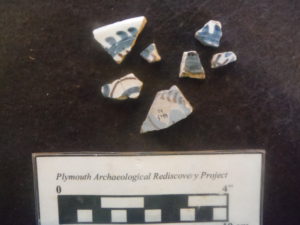Top Row (Left to Right)-
C5-5285 N OF Feature 8 (west cellar).5-1′ BS JUN 60
C5-3809 Feature 2 Sq H (just S. of Hearth) .5-1′ BS
C5-6330 EU 4 (North Yard)0-1′ BS AUG 60
C5-3815 Feature 2 Sq H (just S. of Hearth) .5-1′ BS
C5-3120 Feature 2 Sq G (S. of Hearth)0-.5′ BS 08/08/59
Bottom Row (Left to right)
C5-3892 Feature 1 Sq H (just S. of Hearth).5-1′ BS
C5-3475 Feature 1 Sq G (just S. of Hearth) 0-.5′ BS
C5-5733 Feature 24 Sq A (Southeast Yard) 0-.5′ BS JUN 60
These re all fragments of Portuguese plates. They have been found at other sites around Plymouth, but are very common at the C-5 site. This may be a result of either Benjamin Lothrop’s known merchant activities or possibly earlier small scale shipping and merchant activities of Joseph of James Howland. Portugal’s main export in the 17th and 18th centuries was wine, and vessels such as these may have been purchased by merchants or ship’s captains either for personal use or to be sold when returning to their home port. Portuguese ceramics are very common at English sites in Newfoundland, especially those on the Avalon Peninsula associated with colonists from North Devon. North Devon ceramics were also common at both the John Howland and Joseph Howland sites, possibly indicating some connection with traders from that region.
